Baseball park
A baseball park, also known as a ballpark or diamond, is a venue where baseball is played. A baseball park consists of the playing field and the surrounding spectator seating. While the diamond and the areas denoted by white painted lines adhere to strict rules, guidelines for the rest of the field are flexible.
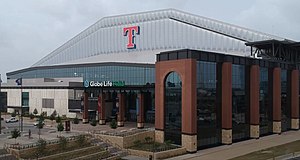
The term "ballpark" sometimes refers either to the entire structure, or sometimes to just the playing field. A home run where the player makes it around the bases, and back to home plate, without the ball leaving the playing field is typically called an "inside-the-park" home run. Sometimes a home run ball passing over an outfield fence (when hit by a batter) is said to have been hit "out of the ballpark", but that phrase more often refers to a home run ball that cleared the stands, landing outside the building. The playing field is most often called the "ballfield", though the term is often used interchangeably with "ballpark" when referring to a small local or youth league facility.[1]
General characteristics
The playing field
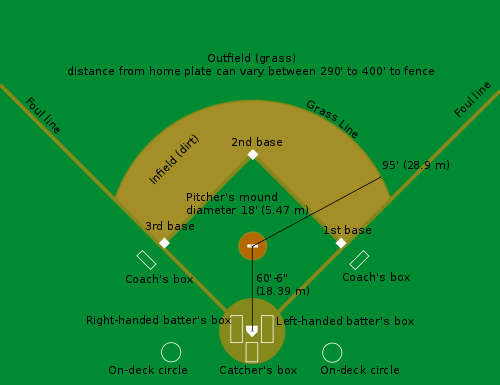
A baseball field can be referred to as a diamond. The infield is a rigidly structured diamond of dirt containing the three bases, home plate, and the pitchers mound. The space between the bases and home is normally a grass surface, save for the dirt mound in the center. Some ballparks have grass or artificial turf between the bases, and dirt only around the bases and pitcher's mound. Others, such as Koshien Stadium in Hyōgo Prefecture, Japan, have an entirely dirt infield.
Two white lines run out from the home plate area, aligned with first and third bases. These are the foul lines or base lines, usually differentiated by referring to them as the first base line, or the third base line. If a ball hit by the batter lands outside of the space between these two lines, or rolls out of this space before reaching first or third base, the ball is "foul" (meaning it is dead and the play is over). If it lands between or on the lines, it is "fair". At the end of the lines are two foul poles, which help the umpires judge whether a ball is fair or foul. These "foul poles" are actually in fair territory, so a ball that hits them on the fly is a home run (if hit on the bounce, it is instead an automatic double).
On either side of home plate are the two batter's boxes (left-handed and right-handed.) This is where the batter stands when at bat. Behind home is the catcher's box, where the catcher and the home plate umpire stand.
Next to first and third base are two coaches' boxes, where the first and third base coaches guide the baserunners, generally with gestures or shouts. As the baserunner faces away from the outfield when running from second base to third, they cannot see where the ball is, and must look to the third base coach on whether to run, stop, or slide.
Farther from the infield on either side are the dugouts, where the teams and coaches sit when they're not on the field. They are named such because, at the professional levels, this seating is below the level of the playing field so as to not block the view from prime spectator seating locations. In amateur parks, the dugouts may be above-ground wooden or CMU structures with seating inside, or simply benches behind a chain link fence.
Beyond the infield and between the foul lines is a large grass outfield, generally twice the depth of the infield. The playing field is bordered by fences of varying height. The infield fences are in foul territory, and a ball hit over them isn't a home run; consequently, they are often lower than the outfield fences to provide a better view for spectators. Sometimes, the outfield fence is made higher in certain areas to compensate for a close proximity to the batter.
In professional parks, the field is surrounded by an area roughly 10 feet (3.0 m) wide made of dirt or rubberized track surface called a "warning track". Originally used in Yankee Stadium in 1923 as an actual footrace track, it is now present in all major league ballparks. This change in terrain warns a fielder, who is watching a ball in the air, that the wall is near, avoiding possible injury.
Beyond the outfield fence in professional parks is an area called the batter's eye. To ensure the batter can see the white ball, the batter's eye contains no seating, and is a darker color. The batter's eye area can be anything from a dark wall to a grassy slope.
Seating
Today, in Major League Baseball, a multi-tiered seating area, a grandstand, surrounds the infield. How far this seating extends down the baselines or around the foul poles varies from park to park. In minor league parks, the grandstands are notably smaller, proportional to expected sizes of crowds compared with the major leagues.
The seating beyond the outfield fence generally differs from the grandstand, though some multi-purpose or jewel box parks have the grandstand surround the entire field. This area could contain inexpensive bleacher seats, smaller grandstands, or simply inclined seating. In local ballparks, there are often simply a set or two of aluminum bleachers on the first-base and third-base sides.
Variations
Distinctive from "goal games" such as football and basketball, which have fixed-size playing areas, the infield is the only rigidly laid-out part of the field. Like its English relative, cricket, there is significant flexibility in the shape and size of the rest of the playing area.
.jpg)
To prevent "cheap" home runs, baseball leagues may specify a minimum distance from home plate to the outfield fences. Generally, the higher the skill level, the deeper the minimum dimensions must be, to prevent an excess of home runs. In the major leagues, a rule was passed in 1958[2] that compelled any new fields built after that point to have a minimum distance of 325 feet (99 m) from home plate to the fences in left and right field, and 400 feet (120 m) to center. (Rule 1.04, Note(a)). This rule was passed to avoid situations like the Los Angeles Coliseum, which was 251 ft (77 m). down the left field line.
However, with the opening of Baltimore's Camden Yards (1992), the "minimum distance" rule began to be ignored. One factor may be that the quaint, "retro" look of Camden Yards, with its irregular measurements, proved to be very popular, along with a traditionalist backlash against the symmetrical, multi-purpose, "cookie-cutter" stadiums. Since the opening of Camden Yards, many other "retro" stadiums have been built, each with asymmetrical fences. These distances vary from park to park, and can even change drastically in the same park. One of the most famous examples is the original Yankee Stadium, whose odd-shaped plot of land caused right field to be over 100 feet (30 m) shorter than left, although this difference lessened over time. The rectangular Polo Grounds had extremely short distance down the lines, 258 ft (79 m). to right and 280 ft (85 m). to left. In contrast, the deepest part of center field was nearly 500 ft (150 m). from home plate.
Older ballparks, such as Fenway Park, were grandfathered in and allowed to keep their original dimensions. Also, new parks have sometimes received special dispensation to deviate from these rules. For instance, the second Yankee Stadium, built 2009, used the same dimensions as the original Yankee Stadium.[3]
The heights of the fences can also vary greatly, the most famous example being the 37-foot (11 m)-high Green Monster in Fenway Park's left field. Such tall fences are often used to stop easy home runs in a section of the ballpark where the distances from home are shorter, or where there is little space between the field and the street beyond.[4] Some in-play scoreboards and high fences reached 50 to 60 feet (18 m), whereas a few outfields were even lined with hedges rather than normal fences or walls. The Hubert H. Humphrey Metrodome, when set up for baseball, had a 23-foot (7.0 m) right field "fence" that was actually a relatively thin blue plastic sheet covering folded up football seats. It was often called the "Baggie" or "Hefty bag".
Some ballparks have irregularly shaped fences. Ballparks may have round swooping fences or rigidly angled fences, or possibly a significant change in direction or irregular angle. For example, the center field stands and the left field stands at Fenway Park meet at an uneven angle, creating an indentation (called "the triangle") that angles sharply back into the stands. In Citi Field and Oracle Park, part of the right field fence juts unevenly into the outfield as if the builders were trying to create an unpredictable ricochet effect for balls hit against it.[1] Some "retro" parks, such as Globe Life Park in Arlington, throw in a sudden and small inward turn (often referred to as a jog) just to give a little quirkiness to the design. Milwaukee's Miller Park was designed, with the help of former player Robin Yount, to promote extra base hits.[5]
Originally (mostly in the old jewel box parks) these variations resulted from the shape of the property where the park was constructed. If there was a street beyond left field, the distance to the left field fence would be shorter, and if the distance was too short, the fence would be higher. For example, in the old Griffith Stadium in Washington, D.C., part of center field had to be built around a cluster of apartment houses and the result was a rather large angular indentation in the left-center field fence.[1] Now, these variations are mostly influenced by the specifications and whims of the designers. New "retro" parks, which try to recapture the feel of the jewel box parks, are often designed to have these quirks.
Etymology
Baseball was originally played in open fields or public parks. The genesis of modern baseball is conventionally connected with Elysian Fields in Hoboken, New Jersey, a large public park where the businessmen of New York City gathered from time to time to play organized baseball games and cricket matches, starting around the mid-1840s. The name "Field" or "Park" was typically attached to the names of the early ballparks.
With the beginnings of professional baseball, the ballfield became part of a complex including fixed spectator seating areas, and an enclosure to restrict access to paying customers, as with a fairgrounds. The name "Grounds" began to be attached to ballparks, starting with the Union Grounds in 1862. The suffixes "Field" and "Park" were still used, but many professional ballparks were "Grounds". The last surviving major league "Grounds" was the Polo Grounds in New York City, which was razed in 1964.
The term "stadium" had been used since ancient times, typically for a running track and its seating area. As college football gained in popularity, the smaller college playing fields and/or running tracks (which also frequently had the suffix "Field") gave way to large stadiums, many of them built during the sport's "boom" of the 1920s. Major league baseball enjoyed a similar boom. One of the first major league ballparks to be called a "stadium" was actually the Polo Grounds, which was temporarily renamed Brush Stadium from its reconstruction in 1911 until the death of owner John T. Brush in the 1920s. By then, the most famous baseball "stadium" of them all had been constructed: Yankee Stadium. From that point until the retro building boom of the 1990s, the suffix "Stadium" was used for almost every new major league ballpark, and was sometimes applied to the old ones, such as Shibe Park, which was renamed Connie Mack Stadium in 1954.
The suffix "Dome" was also used for the indoor stadiums constructed from the 1960s onward. The official names of those arenas also often included the word "Stadium", such as the Houston Astrodome, whose formal name was "Harris County Domed Stadium" in 1965; the Kingdome, whose formal name was "King County Domed Stadium", and the Metrodome, for which the Minneapolis highway signs directed the driver to "Metrodome Stadium". The retro era of the 1990s and early 2000s saw a return to the original arboreal terms, even to domed structures such as T-Mobile Park and Miller Park.
There is little consistency in the choice between "Field" and "Park". For example, Houston's Minute Maid Park was originally named "Enron Field".
Settings
Seating area design of stadiums is affected by many variables, including required capacity, audience access, and road traffic. Early ballparks like Elysian Fields were far from the city center. Each game was an event, and fans traveled by public transit to watch the game.
With the growth of professional leagues, and consequent growth in the quantity of games, each game became less of an event, and fan convenience became more important. Many professional ballparks were built either near the city center, or in working-class neighborhoods, based on expected economic level of the average fan. Consequently, the classic ballparks typically had little space for automobiles, as it was expected that most fans would take mass transit to the games, a situation that still prevails at Boston's Fenway Park and Chicago's Wrigley Field, for example. Some early ballparks, such as Brooklyn's Eastern Park, were abandoned because the trolley lines did not go out far enough and the team was not performing well enough for people to tolerate the inconvenience.
As fans became more affluent, and especially as they moved to the suburbs and bought cars, the lack of parking became an important issue. Some ballparks remedied this problem through the construction of parking garages in the vicinity, or building new ballparks with ample parking. Others built ballparks in the suburbs, typically with large parking areas. The ballpark/stadium thus became an "island" in an "ocean" of parking space.
The modern "retro" trend seeks to cover all the bases: an urban location, with plenty of parking and public transportation available.
Types of baseball parks
Wooden ballparks

The first professional baseball venues were large wooden ballparks with seats mounted on wood platforms. Although known for being constructed out of wood, they featured iron columns for better support. Some included one tier of inclined seating, topped with either a flat roof or, in some instances, a small upper tier. The outfield was bordered by tall walls or fences covered in advertisements, much like today's minor league parks. These advertisements were sometimes fronted with bleacher seats, or "bleaching boards". Wood, while prone to decomposition, was a relatively inexpensive material, as there was no official governing body for professional baseball at the time. However, the use of wood as the primary material presented a major problem, especially as baseball continued to thrive. Over time, the wooden stands aged and dried. Many parks caught fire, and some were leveled completely. This problem, along with the popularization of baseball and expectations for long-term use of the parks were major factors that drove the transition to the new standard materials for ballparks: steel and concrete. Some famous wooden parks, such as the Polo Grounds III in New York and National League Park in Philadelphia, burned and were rebuilt with fire-resistant materials (Polo Grounds IV and Baker Bowl). Others were simply abandoned in favor of new structures built elsewhere. These new fire-resistant parks often lasted for many decades, and (retrospectively) came to be known as "jewel boxes". Since there are no more professional ballparks in existence left with this architectural trend, it's basically a dead design.
| Ballpark | Location | Team | Opened | Closed | Demo'd | Current status |
|---|---|---|---|---|---|---|
| American League Park | Washington, D.C. | Senators | 1901 | 1911 | 1911 | Destroyed by fire. Now residential. |
| Bennett Park | Detroit | Tigers | 1896 | 1911 | 1911 | The Tigers continued to use this site until 1999 (see Tiger Stadium). The field and flagpole from Tiger Stadium remain on the site. |
| Columbia Park | Philadelphia | Athletics | 1901 | 1909 | 1913 | Now residential. |
| Eastern Park | Brooklyn | Grooms | 1891 | 1897 | unknown | Now site of a car junkyard. |
| Exposition Park | Pittsburgh | Pirates | 1890 | 1909 | 1915 | Once a railroad yard, now parking for PNC Park. Interstate 279 runs over a portion of the property. |
| Hilltop Park | Manhattan | Highlanders | 1903 | 1912 | 1914 | Now site of New York–Presbyterian Hospital |
| Huntington Avenue Grounds | Boston | Americans | 1901 | 1911 | 1912 | Now site of Northeastern's Solomon Court at Cabot Center. |
| Kennard Street Park | Cleveland | Blues | 1879 | 1884 | unknown | |
| League Park | Cleveland | Indians Spiders |
1891 | 1909 | 1909 | Now Baseball Heritage Museum and Fannie M. Lewis Community Park at League Park centered on the original diamond.[6][7] |
| Lloyd Street Grounds | Milwaukee | Brewers | 1895 | 1903 | unknown | |
| National League Park | Cleveland | Blues Spiders |
1887 | 1890 | unknown | |
| National League Park | Philadelphia | Phillies | 1887 | 1894 | 1894 | Destroyed by fire. Rebuilt as Baker Bowl. Now commercial. |
| Oriole Park I | Baltimore | Orioles | 1882 | 1889 | 1890? | |
| Oriole Park II | Baltimore | Orioles | 1890 | 1891 | 1892? | |
| Oriole Park III | Baltimore | Orioles | 1891 | 1900 | 1901? | |
| Oriole Park IV | Baltimore | Orioles | 1901 | 1902 | 1903? | |
| Palace of the Fans | Cincinnati | Reds | 1902 | 1911 | 1911 | Replaced on site by Crosley Field. Now parking and commercial. |
| Polo Grounds I | Manhattan | Gothams, Metropolitans | 1880 | 1889 | 1889 | Destroyed by street construction. Now part of West 111th Street. |
| Polo Grounds II | Manhattan | Giants | 1889 | 1891 | 1919? | Now public housing. |
| Polo Grounds III | Manhattan | Giants | 1890 | 1911 | 1911 | Destroyed by fire. Rebuilt as Polo Grounds IV. Now public housing. |
| Recreation Park | Detroit | Wolverines | 1881 | 1888 | 1894 | Now site of the Detroit Medical Center |
| Robison Field | St. Louis | Cardinals | 1893 | 1920 | 1926 | Now site of Beaumont High School |
| South End Grounds | Boston | Beaneaters | 1871 | 1914 | 1914 | Now parking for Mass Transit station |
| South Side Park | Chicago | Colts White Sox |
1893 | 1940 | 1940 | Now site of the Chicago Housing Authority's Wentworth Gardens |
| Terrapin Park (Oriole Park V) | Baltimore | Terrapins | 1914 | 1944 | 1944 | Destroyed by fire. Now commercial |
| Washington Park I | Brooklyn | Grays | 1883 | 1891 | unknown | |
| Washington Park II | Brooklyn | Superbas | 1898 | 1913 | 1913 | Replaced by concrete and steel Washington Park 1914 |
| West Side Park I | Chicago | White Stockings | 1885 | 1891 | unknown | Now site of the Andrew Jackson Language Academy. |
| West Side Park II | Chicago | Cubs | 1893 | 1915 | 1915 | Now site of the University of Illinois Medical Center. |
Jewel box ballparks
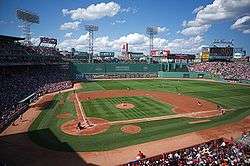
The ballparks built or rebuilt of concrete and steel (albeit with wooden seats) after the days of the wooden ballpark are now known as the jewel box ballparks or classic parks. These parks are said by many to embody the golden age of baseball. They are known for an intimate feel, and major use of reinforced concrete and brick. The first of these was Shibe Park, which opened in 1909 in Philadelphia. Another Philadelphia ballpark, Baker Bowl, which opened in 1895, used steel and brick instead of wood as the primary construction materials and included a cantilevered upper deck seating area that hung out over the lower deck seating area. Though it did not use reinforced concrete in its construction, Baker Bowl is considered the forerunner of the jewel box parks.
Two-tiered grandstands became much more prevalent in this era. These decks were typically held up by steel pillars that obstructed the view from some seats in the lower level. However, because of these supports, the upper decks could come very close to the field, giving the ballpark a more intimate feel. Two tiers was the standard for decades, until the New York Yankees built Yankee Stadium. To accommodate the large crowds Babe Ruth drew, Yankee Stadium was the largest ballpark in baseball and was built with three tiers. This became the new standard until some recently built parks reverted to two, including PNC Park in 2001.
Most jewel box parks were built to fit the constraints of actual city blocks, resulting in asymmetrical outfield dimensions, including Fenway. The exceptions were Shibe Park and Comiskey Park, which were built on rectangular city blocks that were large enough to accommodate left/right field symmetry.
Other sports, such as soccer and football, were often played at these sites (the Polo Grounds and Yankee Stadium were, for example, designed to accommodate football). In contrast to the later multi-purpose parks, the seats were generally angled in a configuration suitable for baseball. The "retro" ballparks built in the 1990s and beyond are an attempt to capture the feel of the jewel box parks. The only jewel box parks still used by Major League Baseball are Fenway Park and Wrigley Field.
| Ballpark | Location | Team | Opened | Lights installed | Closed | Demo'd | Current status |
|---|---|---|---|---|---|---|---|
| Baker Bowl | Philadelphia | Phillies | 1895 | Never | 1938 | 1950 | Now commercial |
| Braves Field | Boston | Braves | 1915 | 1946 | 1952 | 1955 | Reconfigured into BU's Nickerson Field. Only demolished Jewel Box ballpark with a portion of its original stands still standing and in use. |
| Comiskey Park | Chicago | White Sox | 1910 | 1939 | 1990 | 1991 | Now parking for Guaranteed Rate Field. |
| Crosley Field | Cincinnati | Reds | 1912 | 1935 | 1970 | 1972 | Now parking and commercial. |
| Ebbets Field | Brooklyn | Dodgers | 1913 | 1938 | 1957 | 1960 | Now residential. |
| Fenway Park | Boston | Red Sox Braves |
1912 | 1947 | — | — | Active. Renovated heavily from 2002 to 2011 |
| Forbes Field | Pittsburgh | Pirates | 1909 | 1940 | 1970 | 1971 | Now site of University of Pittsburgh's Posvar Hall. Parts of the outfield wall survive. |
| Griffith Stadium | Washington, D.C. | Senators | 1911 | 1941 | 1961 | 1965 | Now site of the Howard University Hospital. |
| League Park | Cleveland | Indians | 1910 | Never | 1946 | 1951 | Now Baseball Heritage Museum, housed in the stadium's original ticket office, and Fannie M. Lewis Community Park at League Park centered on the original diamond.[6][7] |
| Polo Grounds IV | Manhattan | Giants Yankees Mets |
1911 | 1940 | 1963 | 1964 | Now public housing. |
| Shibe Park | Philadelphia | Athletics Phillies |
1909 | 1939 | 1970 | 1976 | Now site of the Deliverance Evangelistic Church. |
| Sportsman's Park | St. Louis | Browns Cardinals |
1902 (rebuilt 1909) | 1940 | 1966 | 1966 | Now site of the Herbert Hoover Boys and Girls Club, with the original playing field still in use for youth sports. |
| Tiger Stadium | Detroit | Tigers | 1912 | 1948 | 1999 | 2009 | The Tigers continued to use this site until 1999. Site currently being redeveloped, with the playing field to be used as a youth sports facility for the Detroit Police Athletic League, but with an artificial surface instead of the original grass field. |
| Wrigley Field | Chicago | Cubs | 1914 | 1988 | — | — | Active. Renovation began in 2014 and was fully completed by Opening Day 2019. |
| Yankee Stadium | The Bronx | Yankees | 1923 | 1946 | 2008 | 2010 | Renovated in 1973–76. Structure demolished and now "Heritage Field" in Macombs Dam Park. |
Multi-purpose ballparks
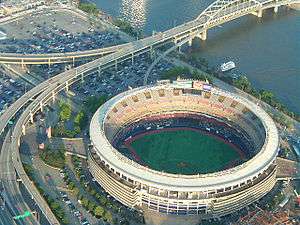
From the 1960s until the arrival of retro parks in 1992, baseball built many multi-purpose ballparks. Also derisively known as "concrete donuts", "cookie-cutters", or "giant ashtrays", they were usually tall and circular or square structures made entirely of, usually bare, reinforced concrete. The parks were built to hold baseball as well as football, soccer, and other sports. One of the earliest baseball stadiums that incorporated this type of design was Cleveland Stadium (built 1932), which featured an oval grandstand that was more friendly to goal-centered sports like football. A park built to suit all sports well, which was co-owned by the teams or the city, seemed advantageous to all, especially because it was less expensive to maintain one stadium rather than two. Some parks that were originally built for one sport were renovated to accommodate multiple sports.
The shape of the parks generally depended on the original use. Baseball parks that were renovated to accommodate football, like Candlestick Park and Anaheim Stadium, were usually asymmetrically shaped. Football stadiums that were renovated to accommodate baseball, like Sun Life Stadium and Mile High Stadium, were usually of a rectangular shape, though Mile High actually started its life in 1948 as a Minor League Baseball park known as Bears Stadium. Parks that were built to serve both were usually circular and completely enclosed on all sides. These were the parks that gained multi-purpose parks the reputation as bland cookie-cutter structures. The first of these parks was DC Stadium (renamed RFK Stadium in 1969) in the District of Columbia. RFK is unique in that it hosted two different baseball teams, and that it was the first to originally be intended for multiple sports.
A notable variant among the cookie-cutter stadia was Shea Stadium. Its grandstand extended just beyond the foul poles, and did not completely enclose the field. Plans were made to enclose the grandstand and build a dome, but engineers discovered that the structure could not handle the load of the proposed dome. Thus the stadium simply remained with the area behind the outfield fence open.
One major innovation of the multi-purpose parks was the cantilevered upper deck. In earlier ballparks, the columns used to support the upper decks obstructed the view from some seats in the lower deck. The upper decks were extended upwards and the columns removed. However, even though the extension counterbalanced some of the weight, the upper decks could no longer extend as close to the field and had to be moved back. Also, the roofs could no longer be as large, and often only covered the top 15 or so rows. This exposed fans to the elements.
Besides the drawbacks of the cantilever design, there were other issues with these parks. With few exceptions, seating was angled to face the center of the field of play, rather than home plate. Luxury boxes, which were a part of football culture, were now introduced to baseball, and were usually placed below the upper decks, pushing upper deck seating farther from the field. The furthest seats in these parks were 500 feet (150 m) or more from the plate. The capacities of these stadiums were staggeringly large, due to football drawing a larger crowd per game. However, they were usually far too large for baseball, further diminishing their intimacy. Even crowds of 40,000, a fair amount for baseball, seemed sparse. Often the only times they looked full were on opening day and playoff games. Due to the rectangular shape needed for football or soccer, outfield dimensions were generally symmetrical, and even seats at field level down the lines could be far from the action.
Such stadiums weren't much better for football. The "cookie-cutters" with swiveling, field-level sections proved problematic. Because the front rows were too close to the field, the fans had difficulty seeing over the football benches. This was evident in the movable seating sections in RFK Stadium. The first ten rows of the football configuration were practically at field level, and fans in those sections often stood up on their seats to get a better view. Other stadiums overcame this simply by covering those seats, not bothering to sell them. Despite being cost-effective, these problems eventually caused the parks to become unfashionable.
The multi-purpose architecture reached a climax when Toronto's SkyDome (now Rogers Centre) opened in 1989. It had state-of-the-art amenities including a retractable roof, hotel, and a restaurant behind the outfield from where patrons could view the games.
Only one of the purely open-air multi-purpose parks is still in use today: Oakland Coliseum. The Athletics plan to move out of Oakland Coliseum and build a new ballpark of their own in the future, and their former co-tenants, the NFL Oakland Raiders, moved to Las Vegas in 2020.
Note: To reduce redundancy, this table does not list the indoor stadiums of the multi-purpose era in this section. However, all of the indoor ballparks of North America, which are listed in their own section, were also built as multi-purpose stadiums, except for Tropicana Field.
| Ballpark | Location | Team | Opened | Closed | Demo'd | Current status | Football |
|---|---|---|---|---|---|---|---|
| Anaheim Stadium* | Anaheim, California | Angels | 1966 | — | — | Active. Renovated in 1979–80 to multipurpose and in 1996–98 back to baseball-only. | Rams |
| Atlanta–Fulton County Stadium | Atlanta | Braves | 1966 | 1996 | 1997 | Served as parking for Turner Field until the Braves moved to Truist Park after the 2016 season. Georgia State University now plans to build a new ballpark within the original stadium footprint. | Falcons |
| Busch Memorial Stadium | St. Louis | Cardinals | 1966 | 2005 | 2005 | Plaza area for Busch Stadium III. | Cardinals Rams |
| Candlestick Park* | San Francisco | Giants | 1960 | 2013 | 2015 | Renovated in 1971–72 to multipurpose; closed for baseball in 1999. | Raiders* 49ers |
| Cleveland Municipal Stadium | Cleveland | Indians | 1931 | 1995 | 1996 | Now site of FirstEnergy Stadium. | Indians Rams Browns |
| Canadian National Exhibition Stadium** | Toronto | Blue Jays | 1959 | 1989 | 1999 | Now site of BMO Field. | Argonauts |
| Memorial Stadium | Baltimore | Orioles | 1950 | 1997 | 2001 | Now residential. | Colts Stallions Ravens |
| Mile High Stadium* | Denver | Rockies | 1948 | 2001 | 2002 | Originally a minor-league baseball stadium in 1948. Now parking for Broncos Stadium at Mile High. | Broncos |
| Oakland Coliseum | Oakland, California | Athletics | 1966 | — | — | Active; Athletics plan to move to a new ballpark in the indefinite future. | Raiders |
| Qualcomm Stadium | San Diego | Padres | 1967 | — | — | Inactive; closed for baseball in 2003. | Chargers |
| Robert F. Kennedy Memorial Stadium | Washington, D.C. | Senators Nationals |
1961 | — | — | Inactive; closed for baseball in 2007. To be demolished by 2021. [8] | Redskins |
| Riverfront Stadium | Cincinnati | Reds | 1970 | 2002 | 2002 | Now Cincinnati Reds Hall of Fame and Museum. | Bengals |
| Rogers Centre |
Toronto | Blue Jays | 1989 | — | — | Active | Argonauts Bills |
| Shea Stadium | Queens | Mets Yankees |
1964 | 2008 | 2009 | Now parking for Citi Field and the USTA Billie Jean King National Tennis Center. | Jets Giants |
| Sun Life Stadium** | Miami Gardens, Florida | Marlins | 1987 | — | — | Active; built as a football-only stadium in 1987, renovated in 1991–92 to multipurpose, closed for baseball in 2012. Heavily renovated into football only in 2015. | Dolphins |
| Three Rivers Stadium | Pittsburgh | Pirates | 1970 | 2000 | 2001 | Now largely parking for Heinz Field and PNC Park. Stage AE and the Root Sports Pittsburgh studios occupy parts of the site. | Steelers |
| Veterans Stadium | Philadelphia | Phillies | 1971 | 2003 | 2004 | Now parking for Citizens Bank Park, Wells Fargo Center and Lincoln Financial Field. | Eagles |
*A baseball-only ballpark converted to a multi-purpose stadium.
**A football-only stadium converted to a multi-purpose stadium.
![]()
Modern ballparks
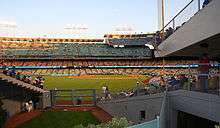
While most teams turned to multi-purpose parks, some chose to build baseball-only parks. While these modern ballparks shirked some of the conventions of multi-purpose parks, they did include some of the new features. The most notable influences were the cantilevered upper decks, the use of seating colors other than green, fairly plain concrete exteriors, and symmetrical outfields. The most important things, though, were that they had a more intimate feel to them, and they were built for baseball. While the multi-purpose parks have become all but extinct, some modern parks, such as Dodger Stadium and Kauffman Stadium, have been hailed for aging beautifully. Rather than build new parks, the teams have decided instead to renovate the current structures, adding a few newer conveniences. Several of the modern parks built as such have remained in use, with no indication of being demolished.
While Cleveland Stadium is the ancestor to the multi-purpose ballpark, the ancestor of the modern ballpark is Milwaukee County Stadium. It was the first to feature a symmetrical, round outfield fence. It also featured the rounded V-shaped grandstand and colorful seats that are common among all modern parks. Coincidentally, it also would have been one of the earlier examples of a converted park as well. It was supposed to replace a minor league facility, and serve as home of the minor league team until a major league franchise could be lured to the city. However, the Braves came to Milwaukee earlier than expected, and the minor league team never played in the stadium.
The first two truly modern ballparks were built by the two New York teams who moved to California, the Giants and the Dodgers. Candlestick Park was created first, but was converted to a multi-purpose park to accommodate the 49ers. Dodger Stadium has been upgraded a number of times, but remains baseball-only and its original design is still largely intact.
Anaheim Stadium, which was initially modeled closely on Dodger Stadium, was expanded for football as was Candlestick, but once the Rams departed, most of the extra outfield seating was peeled back, returning the structure to more like its original design.
The original Yankee Stadium is an exceptional case. Yankee Stadium was a jewel box park, albeit a very large one. It was showing its age in the 1970s, and the stadium was extensively renovated during 1973–75, converting it into more of a modern style ballpark. Many of the characteristics that defined it as a classical jewel box were also retained, so the remodeled Stadium straddled both categories.
New Comiskey Park (now Guaranteed Rate Field) was the last modern ballpark to be built in North America. A series of renovations have been made to make it appear more like a retro-classic ballpark.
Although they were purposefully built for baseball, some of these stadiums also hosted professional soccer and football teams at times. The Minnesota Vikings played at Metropolitan Stadium during the Twins' entire tenure there, and the Green Bay Packers played a few home games at Milwaukee County Stadium every year from 1953 through 1994. A few of them, including Metropolitan Stadium, also hosted NASL teams during the 1970s.
| Ballpark | Location | Team | Opened | Closed | Demo'd | Current status |
|---|---|---|---|---|---|---|
| Angel Stadium | Anaheim, California | Angels | 1966 | — | — | Active. Renovated in 1979–80 for football and in 1996–98 back to baseball-only. |
| Candlestick Park | San Francisco | Giants | 1960 | 2013 | 2015 | Renovated in 1971–72 for football. |
| Dodger Stadium | Los Angeles | Dodgers Angels |
1962 | — | — | Active. |
| Guaranteed Rate Field | Chicago | White Sox | 1991 | — | — | Active. Renovated heavily from 2001 to 2011. |
| Kauffman Stadium | Kansas City, Missouri | Royals | 1973 | — | — | Active. Renovated heavily from 2007 to 2009. |
| Metropolitan Stadium | Bloomington, Minnesota | Twins | 1956 | 1981 | 1985 | Now site of the Mall of America. |
| Milwaukee County Stadium | Milwaukee | Braves Brewers |
1953 | 2000 | 2001 | Now site of Helfaer Field along with parking for Miller Park. |
| Tropicana Field | St. Petersburg, Florida | Rays | 1990 | — | — | Active. Indoor. |
| Yankee Stadium I | The Bronx | Yankees | 1923 | 2008 | 2010 | Renovated heavily from 1973–76. Now a part of Macombs Dam Park. |
Temporary and converted ballparks
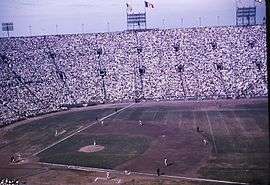
With the 1960s came the first expansion teams. This led to the emergence of two distinct subsets of parks in the major leagues: temporary ballparks and converted ballparks.
In some cases, there are plans to build a new ballpark for the expansion team, but it will not be completed until a few years after the team is established. This may be for a few reasons, such as delays or a desire to hold off until the deal is settled. In this case, an established building is used as a temporary home, often a minor league park. The first temporary ballparks were not actually used by expansion teams but by established franchises. When the Dodgers and Giants moved to California from New York, they played in Los Angeles Memorial Coliseum and Seals Stadium respectively while Dodger Stadium and Candlestick Park were being built.
The other case is when, rather than building a new park, the city renovates an existing minor league or college facility, expanding it to fit a major league team. These converted ballparks are different from football stadia that were converted to facilitate baseball in that converted ballparks were originally built to be baseball only, albeit for a non-major league level. Early converted ballparks were Memorial Stadium in Baltimore, Municipal Stadium in Kansas City, and Metropolitan Stadium in Bloomington, Minnesota. All three were expanded minor league facilities, although Baltimore and the Met were constructed with the idea of expanding to major league level in mind. Kansas City was a true established minor league park that was substantially expanded to accommodate major league size crowds.
These two types of ballpark are distinct because of their use, not their design. Because of this, a temporary or converted ballpark can also be any of the other types: jewel box, modern, multi-purpose, etc.
| Ballpark | Location | Team | Opened | Closed | Demo'd | Current status |
|---|---|---|---|---|---|---|
| Arlington Stadium | Arlington, Texas | Rangers | 1965 | 1993 | 1994 | Now parking for Globe Life Park in Arlington. |
| Colt Stadium | Houston | Colt .45's | 1962 | 1964 | 1970 | Dismantled and rebuilt in Mexico as Mexican League park. |
| Jarry Park Stadium | Montreal | Expos | 1969 | 1976 | 1993 | Converted to a tennis venue now known as Stade IGA. |
| Kansas City Municipal Stadium | Kansas City, Missouri | Athletics Royals |
1923 | 1972 | 1976 | Now a municipal garden. |
| Los Angeles Memorial Coliseum | Los Angeles | Dodgers | 1923 | — | — | Active; closed for baseball in 1961. Holds the baseball world record attendance when 115,300 attended a pre-season exhibition game between the Dodgers and Boston Red Sox on March 29, 2008. |
| Memorial Stadium | Baltimore | Orioles | 1950 | 1997 | 2001 | Now residential. |
| Metropolitan Stadium | Bloomington, Minnesota | Twins | 1956 | 1981 | 1985 | Now site of the Mall of America. |
| Mile High Stadium | Denver | Rockies | 1948 | 2001 | 2002 | Originally a minor-league baseball stadium in 1948. Now parking for Broncos Stadium at Mile High. |
| Seals Stadium | San Francisco | Giants | 1931 | 1959 | 1959 | Now a shopping center. |
| Sick's Stadium | Seattle | Pilots | 1938 | 1976 | 1979 | Now a Lowe's store. |
| Wrigley Field | Los Angeles | Angels | 1925 | 1965 | 1966 | Now Gilbert Lindsay Park. |
Indoor ballparks
An important type of ballpark is the indoor park. These parks were covered with a fixed roof, usually a hard concrete dome. Reasons to build indoor parks were varied. The Astrodome, the first indoor sports stadium ever built, was built to escape the hot and very humid climate of Houston and the Kingdome was built to escape Seattle's constant rains. There is little to no natural light in these parks, necessitating the use of one of the most distinguishing aspects of an indoor park: artificial turf. Since there was not enough light to grow grass, artificial turf was installed, and this affected the game. Artificial turf was harder, and thus a ball hit on the ground moved faster and bounced high. This, coupled with the usually dull white or gray roofs that could camouflage a fly ball, caused what Twins fans called a "dome-field advantage".
A park of note is Olympic Stadium in Montreal. The park was designed with a large tower that loomed over top. Cables came down from the top of the tower to connect to the large oval center of the roof. This oval center was supposed to be lifted by the cables, opening the park up if the weather was pleasant. However, the mechanism never worked correctly, and what was supposed to be a retractable roof was initially not used, then used for only a short period of time, and later replaced with a permanently fixed roof, making the stadium a strictly indoor facility.
Another notable park was the Hubert H. Humphrey Metrodome in Minneapolis, which instead of a rigid masonry roof was covered by inflatable fiberglass sheeting, held up by air pressure. A drawback to this design, at least in Minnesota's severe winter climate, was revealed when the dome collapsed three times in its first three years of operation due to accumulated snow.
Indoor parks faced many of the same problems of the multi-purpose parks, which was compounded with the added problem of playing an outdoors sport indoors. Tropicana Field is the only indoor-only or fixed-dome park left hosting a Major League Baseball team, and may be replaced in the near future. It also is the only non multi-purpose indoor baseball stadium.
| Ballpark | Location | Team | Opened | Closed | Demo'd | Current status | Football |
|---|---|---|---|---|---|---|---|
| Astrodome | Houston | Astros | 1965 | 2004 | — | Structure still standing but has not seen regular use since its closure. Most recently served as a shelter for people displaced by Hurricane Katrina and Hurricane Rita. | Oilers |
| Hubert H. Humphrey Metrodome | Minneapolis | Twins | 1982 | 2013 | 2014 | Now site of U.S. Bank Stadium, which opened in 2016. | Vikings |
| Kingdome | Seattle | Mariners | 1976 | 2000 | 2000 | Now site of CenturyLink Field, which opened in 2002. | Seahawks |
| Olympic Stadium | Montreal | Expos | 1976 | — | — | Active. Closed for baseball in 2004 when Expos moved to Washington, D.C., and became the Washington Nationals. | Alouettes |
| Tropicana Field | St. Petersburg, Florida | Rays | 1990 | — | — | Active. | N/A |
Retractable-roof ballparks
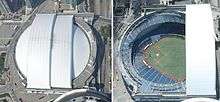
The indoor parks were built for several different reasons, chief among those weather. However, as multi-purpose parks became unfashionable, so did the drab indoor parks. This led to the creation of retractable-roof parks. These allowed shelter from the elements, but still could be opened on a nice day. To be able to support the roof, most were closed in on all sides like multi-purpose and indoor parks, but as all retractable-roof parks except Rogers Centre are baseball only, every square foot does not need to be filled with seating, and there is plenty of room for open spaces or windows that look outside.
Because the roof needs to go somewhere when not covering the field, a distinguishing characteristic of the retractable roof park is a large extension of the interior spaces to either one side of the field or both sides that the roof sits on when retracted. The only exception to this is Miller Park whose fan-shaped roof folds in upon itself and hangs behind the stands down the foul lines. Often, when retracted, the roof still hangs over the field, casting large shadows. This is countered at Miller Park by large panes of glass under the roof. While most stadiums seal up when the roof is closed, others are at least partially open, with large gaps that do not let in harsh weather, but don't give the feel of being inside, such as T-Mobile Park, whose roof acts as an "umbrella" to shield from Seattle's frequently rainy weather.
Pittsburgh's Civic Arena was the first sports building in the world with a retractable roof; however, the building was originally constructed for the Pittsburgh Civic Light Opera, which moved out in 1969 due to dissatisfaction with the acoustics in the arena. The arena's long-term tenants, the NHL's Pittsburgh Penguins, never played with the roof open, and the arena itself was never used for baseball. While Montreal's Olympic Stadium was the first baseball park to have a retractable roof, the roof was plagued by numerous problems, and was never fully used. As a result, it is not generally considered to be a retractable-roof facility. This made Rogers Centre the first fully functional retractable-roof park. It managed to succeed where Olympic Stadium failed, building a multi-section roof that folded upon itself, retracting over the hotel in center field.
Retractable-roof parks can vary greatly in style, from the utilitarian (Rogers Centre), to those infused with retro elements (such as Minute Maid Park), to the contemporary (Marlins Park). The style of each park reflects the popular architecture of the era in which it was built. (This differs from indoor ballparks — all of which were built during the time of multi-purpose parks, and thus reflected the same "flying-saucer" style.) When Rogers Centre opened in 1989, baseball was near the end of the modern and multi-purpose era. Chase Field, T-Mobile Park, Minute Maid Park, and Miller Park all opened in the middle of the retro era. When Marlins Park opened in 2012, it introduced a new and different style, and perhaps the beginning of a new era.[9] The Texas Rangers built Globe Life Field in the retro style similar to their previous ballpark, Globe Life Park.[10]
Therefore, the term "retractable-roof ballpark/stadium" is not a description of the overall architectural style of the building, but of the functional aspect of it. For this reason, retractable-roof parks are also dual-listed in style-based types of ballparks. For example, the 4 retractable-roof parks built during the retro era are also considered to be retro-modern ballparks.
| Ballpark | Location | Team | Opened | Closed | Demo'd | Current status |
|---|---|---|---|---|---|---|
| Chase Field | Phoenix, Arizona | Diamondbacks | 1998 | — | — | Active |
| Globe Life Field | Arlington, Texas | Rangers | 2020 | — | — | Active |
| Marlins Park | Miami | Marlins | 2012 | — | — | Active |
| Miller Park | Milwaukee | Brewers | 2001 | — | — | Active |
| Minute Maid Park | Houston | Astros | 2000 | — | — | Active |
| Rogers Centre | Toronto | Blue Jays | 1989 | — | — | Active |
| T-Mobile Park | Seattle | Mariners | 1999 | — | — | Active |
Retro-classic ballparks
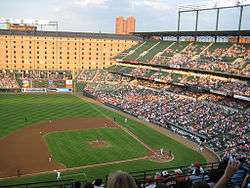
HOK Sport designed Sahlen Field in Buffalo to attract a major league franchise to the city. The stadium opened in 1988 as home of the Buffalo Bisons, but was passed over in the 1993 Major League Baseball expansion. HOK Sport would take what they learned in Buffalo about styling a retro-classic ballpark, or retro ballpark, to their major league project in Baltimore.
In 1992, Oriole Park at Camden Yards opened in Baltimore. Going in a different direction from the multi-purpose and modern ballparks, Camden Yards harkened back to the old jewel box parks. This began the trend of building of retro-classic ballparks in Major League Baseball.
The retro parks were built with all the luxuries of the newer parks, such as luxury boxes and more restrooms and concession areas, along with new additions, such as indoor concourses that are open to the field, allowing fans to always have a view of the game. However (except for a few exceptions harkening back to the wooden ballpark era), the aesthetics shifted back to jewel box conventions, which included the use of green seats, bricks, stone, and green-painted exposed steel.
A major divergence from jewel boxes was the layout of the grandstand. The focus was now on everyone in the park having a good view. Columns were missing as with the modern parks, but the upper deck was drawn back and shrunk, while the middle tiers grew in size, causing a stepped effect. The cantilevered upper deck was no longer a large necessity. However, since these new upper decks were drawn back, the shape of the inclined seating was clearly expressed on the exterior, a feature that is a hallmark of modern parks.
Like the jewel box parks, the outfield fences were angled rather than the gradual curve of the newer parks, and often had quirky dimensions. The requirements for minimum distance to the outfield fences were frequently waived during this time.
Teams with multi-purpose and indoor parks longed for this beautiful and classic look, and began systematically demolishing them and moving to either retro-classic or retro-modern parks. Since Camden Yards opened, two-thirds of all major league teams have opened new ballparks, each of which contain unique features. The most important feature was that they were built primarily for baseball, although these venues have also hosted football, soccer and ice hockey games. Turner Field was originally constructed as Centennial Olympic Stadium for the 1996 Summer Olympics and was retrofitted to baseball the following year.
Guaranteed Rate Field has an unusual place in ballpark history. It was the last modern park built, a year before Camden Yards and hence just missing the retro movement. It was viewed as obsolete only a year into its life. The White Sox responded with a series of renovations to give the park more retro charm. This included the changing from a cantilever upper deck to a flat roof with columns, the change from a symmetrical fence to a more recognizably-shaped asymmetrical fence, and the adoption of a primarily dark-green color scheme, reminiscent of the original Comiskey Park. Upper deck seating was also reduced to eliminate locations which had proven unpopular with fans, and often went conspicuously unsold.
The most recent retro-classic ballparks were built in New York City. Queens' Citi Field is modeled after Ebbets Field, and the Bronx's Yankee Stadium is modeled after the pre-renovation "House that Ruth Built". Both parks opened in 2009.
Teams are now trending away from the retro-classic look and are instead building retro-modern and contemporary ballparks. Turner Field was the first retro-classic park replaced, as the Atlanta Braves moved to Truist Park after the 2016 season, while the Texas Rangers moved from Globe Life Park in Arlington to the new retractable-roof Globe Life Field in 2020.
| Ballpark | Location | Team | Opened | Closed | Demo'd | Current status |
|---|---|---|---|---|---|---|
| Busch Stadium III | St. Louis | Cardinals | 2006 | — | — | Active |
| Citi Field | Queens | Mets | 2009 | — | — | Active |
| Citizens Bank Park | Philadelphia | Phillies | 2004 | — | — | Active |
| Comerica Park | Detroit | Tigers | 2000 | — | — | Active |
| Coors Field | Denver, Colorado | Rockies | 1995 | — | — | Active |
| Globe Life Park in Arlington | Arlington, Texas | Rangers | 1994 | — | — | Active. Closed for baseball in 2019. Redeveloped as a multi-purpose stadium for North Texas SC of USL League One.[11] |
| Guaranteed Rate Field | Chicago | White Sox | 1991 | — | — | Active. Renovated heavily from 2001–2011. Originally a Modern ballpark. |
| Oracle Park | San Francisco | Giants | 2000 | — | — | Active |
| Oriole Park at Camden Yards | Baltimore | Orioles | 1992 | — | — | Active |
| PNC Park | Pittsburgh | Pirates | 2001 | — | — | Active |
| Sahlen Field | Buffalo | Blue Jays | 1988 | — | — | Active |
| Turner Field | Atlanta | Braves | 1996 | — | — | Active. Closed for baseball in 2016. Redeveloped as Georgia State Stadium for Georgia State Panthers football.[12] |
| Yankee Stadium II | The Bronx | Yankees | 2009 | — | — | Active |
Retro-modern ballparks
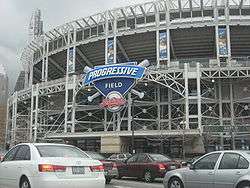
While Camden Yards influenced nearly every ballpark built after it, not all fully adhere to its design. Those that deviate to incorporate more modern-looking elements are called retro-modern ballparks.
Progressive Field was built two years after Camden Yards, and featured the angular, asymmetrical fences of varying heights, a smaller upper deck, stepped tiers, and an unobtrusive singular color scheme. While the interior has all the hallmarks of a retro park, the exterior did not feature the look of the jewel box parks. It could not truly be called a retro-classic park.
Many of today's parks have followed in this second school of retro. Rather than brick, the exteriors heavily feature white- or gray-painted steel. If there is any masonry, it is sandstone or limestone. Some feature progressive elements such as curtain walls, or retractable roofs.[13]
Angel Stadium of Anaheim has seen many changes throughout the years. It was originally a modern park, similar to the Angels' previous home, Dodger Stadium. When the NFL's Los Angeles Rams left the Los Angeles Memorial Coliseum in 1980 and set up shop in what was then Anaheim Stadium, the first round of renovations began. The grandstand was expanded to completely enclose the stadium, turning it into a multi-purpose park. The Rams left in 1994, leaving the Angels alone in the large, 65,000-seat stadium. After a two-year renovation, the steel was painted green, and what concrete remained was painted sandstone, including the sweeping curve of the entrance plaza. The seating configuration was significantly altered, most notably by tearing out most of the outfield seating except for parts of the lower decks in left and right fields, to more closely resemble the original design from the park's first 15 years. The finished product in 1998 was a retro-modern ballpark.
The same year, when Chase Field opened for the expansion Arizona Diamondbacks, it incorporated a retractable roof and a swimming pool — elements that did not exist in jewel-box ballparks. Despite the absence of MLB history in the Phoenix area and an overwhelming roof design, much of the interior was still built with all of the hallmarks of retro, similar to Progressive Field. Although Chase Field was not the first retractable-roof ballpark in history, it was the first in a wave of four retractable-roof ballparks (opening within just four years) to follow the retro-modern pattern.
During the second decade of retro, Petco Park and Kauffman Stadium followed the construction and renovation concepts of Progressive Field and Angel Stadium, respectively. Meanwhile, the period saw another subset of three new retro-modern stadiums that pushed away from classic parks even more.
When Great American Ball Park opened in 2003, it featured a contemporary-looking, glass-wrapped facade. Such prominent use of elements that were unfamiliar even to pre-1992 modern stadiums signaled that some stadium planners were more willing to incorporate designs that looked into the 21st century as much as they did the 20th. Five years later, Nationals Park built off Cincinnati's design, making yet more liberal use of glass along with white concrete that would not clash with architecture in the District. Nationals Park became the first stadium to go green while still offering all of the amenities — another concept that looked ahead instead of behind.[14] The retro-modern style climaxed in 2010 with the sculptured, contemporary exterior and canopy of Target Field, rendering it almost unrecognizable from the outside. Its cantilevered glass on top of a limestone base was designed partly to functionally fit the tiny 8-acre plot in the middle of a bustling transportation interchange. But the principal architect of Target Field, Earl Santee of Populous, said that the exterior was also an artistic interpretation of the culture of Minnesotans: a dichotomy of cosmopolitan and natural.[15] Designing the building as a metaphor for people was a different way of thinking about ballpark architecture.
The exterior of the later retro-contemporary trio of ballparks progressively evolved further and further from jewel-box or even modern-style parks. Yet, in the stands and on the field they still have the familiar classic feel while implementing the marks of retro (i.e., unique-shaped fences, forest green or other singular color scheme, etc.).[13]
| Ballpark | Location | Team | Opened | Closed | Demo'd | Current status |
|---|---|---|---|---|---|---|
| Angel Stadium of Anaheim | Anaheim, California | Angels | 1966 | — | — | Active. Renovated in 1979–80 and again in 1996–98 |
| Chase Field |
Phoenix, Arizona | Diamondbacks | 1998 | — | — | Active |
| Globe Life Field |
Arlington, Texas | Rangers | 2020 | — | — | Active |
| Great American Ball Park | Cincinnati | Reds | 2003 | — | — | Active |
| Kauffman Stadium | Kansas City, Missouri | Royals | 1973 | — | — | Active. Renovated heavily from 2007 to 2009. |
| Miller Park |
Milwaukee | Brewers | 2001 | — | — | Active |
| Minute Maid Park |
Houston | Astros | 2000 | — | — | Active |
| Nationals Park | Washington, D.C. | Nationals | 2008 | — | — | Active |
| Petco Park | San Diego | Padres | 2004 | — | — | Active |
| Progressive Field | Cleveland | Indians | 1994 | — | — | Active. Renovated heavily from 2014 to 2016. |
| T-Mobile Park |
Seattle | Mariners | 1999 | — | — | Active |
| Target Field | Minneapolis | Twins | 2010 | — | — | Active |
| Truist Park | Atlanta | Braves | 2017 | — | — | Active |
![]()
Contemporary ballparks
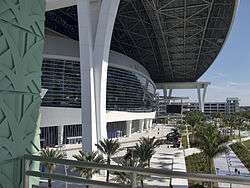
Prior to the start of the 2012 baseball season, USA Today noted that new Marlins Park would "perhaps provide a coda to the postmodern Camden Yards era".[16] After 2 decades of the retro style dominating ballpark architecture, a new type of design emerged in 2012 with the opening of Marlins Park, snapping the consecutive streak of 20 new (plus 3 renovated) MLB retro stadiums. This latest style's purpose is to make the fan experience the present-day culture of the stadium's surrounding city or area, and rejects the basic notion of retro. Stadium planners are calling the style contemporary.
A contemporary stadium for Tampa Bay was designed, but the project was cancelled. The New Yorker wrote regarding the new MLB architecture: "The retro mold has finally been broken, but this might be the last chance a new style gets for some time." [17]
| Ballpark | Location | Team | Opened | Closed | Demo'd | Current status |
|---|---|---|---|---|---|---|
| Marlins Park |
Miami | Marlins | 2012 | — | — | Active |
![]()
Current Major League ballparks
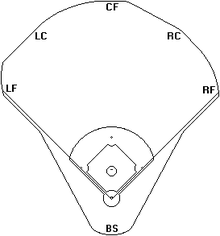
The numbers indicate the number of feet from home plate to the wall of that part of the field. Left and Right Field normally refer to the distances along the foul lines. Left Center and Right Center are the approximate power alley figures. Center Field could mean straightaway center field or it could mean to the deepest part of the center field area. Backstop refers to the distance behind home plate to the backstop screen. These numbers [18] are one researcher's opinion of the true values and may differ from the numbers marked on the wall/fence by as much as 30 feet (9.1 m). Capacity[19] figures may also vary.
In 1958 MLB instituted a rule mandating that parks built thereafter have minimum outfield distances of 325' down the lines and 400' to center; older parks were grandfathered. Since then, however, numerous waivers have been granted, as can be seen from the table.
* Fenway Park is 37,227 during day games
** RingCentral Coliseum is expandable to 55,945.
*** Tropicana Field is expandable to 42,735.
†Actual distance to center field is 400 feet (122 m); the 395 feet (120 m) markings are to the left and right of dead center.[23]
††At Fenway Park, deep center is 379 feet (116 m) and straightaway center is 389.75 feet (119 m).
†††At Progressive Field, the distance to deep center field is 410 feet (125 m) and straightaway center is 400 feet (122 m).
Unique features and quirks of current major league parks
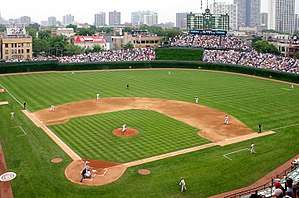

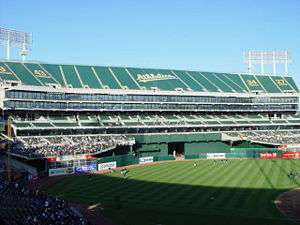

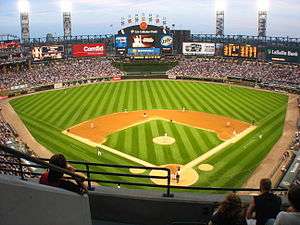
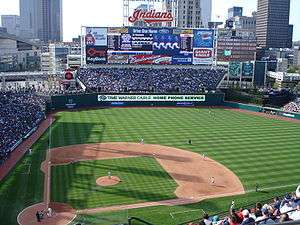
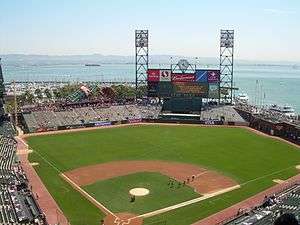

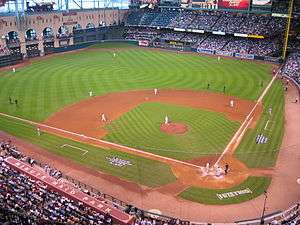

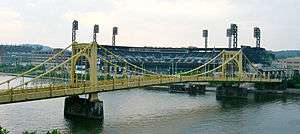
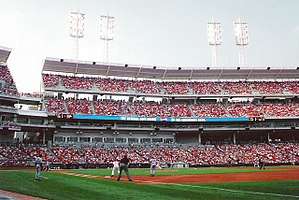
Parks are ordered by date of construction.
- Fenway Park (Boston Red Sox) – Fenway is possibly the most notoriously quirky ballpark. The aforementioned 37-foot (11 m) Green Monster in left field, which includes a field-level manually operated scoreboard and a ladder, leads to unpredictable ricochets. So do the oddly angled fences in center and right field. While the Monster in left dominates the park, Fenway's right center field is 380 at its deepest point, a large divergence from the short left field. The curve of the fence comes in as it nears "Pesky's Pole", named for former Red Sox player Johnny Pesky, and the distance from home plate to the foul pole is only 302 feet (92 m). Despite this being the shortest foul line in baseball, home runs in this area are relatively rare.
- Wrigley Field (Chicago Cubs) – Wrigley is the only major league ballpark left in use that has a brick outfield fence. This fence is mostly covered in Wrigley's trademark ivy. From time to time, a batted ball becomes lodged in the vines, which is ruled a ground rule double. Because there are streets close beyond the outfield fences, there is little room for seating or other structures, making the park open in the outfield. This, coupled with the park's proximity to Lake Michigan, which affects the wind currents from day to day or even hour to hour, can change the dynamic of the park. When the wind is blowing in, the park becomes a pitcher's park, despite the cozy power alleys. When the wind is blowing out, however, it becomes a hitter's park. The openness of the ballpark also allows residents of the buildings across the street to get an unobstructed view of the field. Some owners even have installed small sections of inclined seating on top of the buildings. Wrigley was the last major league park to install field lights, with the first night home game being played in 1988.
- Dodger Stadium (Los Angeles Dodgers) – The view beyond the outfield is dominated by hills and the San Gabriel Mountains, and on one of the hills, large block letters have been erected that spell out "THINK BLUE", reminiscent of the Hollywood Sign (which can be seen from the top deck of the stadium facing away from the field). The setting Sun often reflects off the hills and can give the pitchers a distinct advantage, which the Dodgers have capitalized upon frequently. The Dodger Stadium grandstand is sculpted into the side of a man-made hill, in the fashion of the ancient Roman amphitheaters. This enabled the construction of multileveled terraced parking lots, which allow patrons to park their cars on the same level as their seats, thus minimizing vertical climbing and the need for elevators, escalators and ramps. One perceived drawback of this design is that it does not allow spectators to easily move from one seating level to another. The top of a ten-story elevator shaft bearing the Dodger logo rises behind home plate atop the upper seating level. The massive tiers consist of varicolored seats (yellow, light orange, turquoise, and sky blue), and the right and left field seats consist of little-league-style bleachers topped by a wavy roof. Dodger Stadium has become famous for the no-gimmick, nostalgic baseball atmosphere created by the aesthetic simplicity of the ballpark's design. The slogan for the stadium is "Blue Heaven on Earth".
- Angel Stadium of Anaheim (Los Angeles Angels) – Beyond the left field fence is a rock outcropping with water running down the center of it. At the top are three rocks forming an "A". Commonly known as the California Spectacular (or simply the Spectacular), the outcropping contains pyrotechnics that fire after home runs and wins. The roof over the dugouts continues, connecting the two to form a dugout-level seating. The parking lot contains a large "A" with a halo, which once held the stadium's scoreboard. There are also two giant red caps at the front gate with the cement painted in the form of a miniature baseball diamond in front of the home plate entrance. Behind the caps are oversized bats attached to a baseball which "hold-up" the stadium marquee and is attached to the façade.
- RingCentral Coliseum (Oakland Athletics) – The Coliseum is dominated by a section of seating derisively known as "Mount Davis". To lure the Raiders football team from Los Angeles back to Oakland, seats needed to be added to satisfy owner Al Davis. Thus, the 6-floor seating area was added, blocking the view of the hills beyond. The Coliseum is also known for its immense foul territory, which results in many popped-up foul balls that would go well into the seats in other stadiums being easily caught for outs.
- Kauffman Stadium (Kansas City Royals) – Kauffman is best known for having a 322-foot (98 m) fountain and waterfall display, known as the Water Spectacular, the largest privately funded fountain in the world. The fountains are on display before and after the game and in-between innings, while the waterfalls are constantly flowing. The 12-story iconic crown-shaped scoreboard holds the largest video board in MLB. The stadium is also noted for having the best hitter's background in the American League.
- Rogers Centre (Toronto Blue Jays)- The first fully functional retractable roof over a baseball stadium rests here, and is a unique system, with the larger section folding into a smaller semicircle that looms over the field. Under this sits glassed-in seating and one of the world's largest Jumbotron screens. The 348-room Renaissance Toronto Hotel is also located within stadium, with 70 rooms overlooking the field. The CN Tower next door stands tall over the park. This stadium is the last of the "squared-circle" designs that were similar to Qualcomm Stadium and the now-demolished Veterans Stadium.
- Guaranteed Rate Field (Chicago White Sox) – The old Comiskey Park was well known for what was called the "Exploding Scoreboard". This scoreboard was reincarnated in the new park. Holding a huge video screen, the scoreboard features sound effects and fireworks that go off after wins and home runs and is topped by iconic spinning pinwheels.
- Oriole Park at Camden Yards (Baltimore Orioles) – Camden Yards is the park that began the retro ballpark craze (although the minor-league Sahlen Field in Buffalo, designed by the same firm, predates Camden Yards by four years). Its green seats, its brick and steel finish, and its irregular grandstand configuration all hearken back to the good ol' days. Beyond the bleachers in right and right center is a wall of brick columns with black iron gates. Beyond that looms the large B&O Warehouse, a very prominent feature of the park.
- Progressive Field (Cleveland Indians) – This is the first retro-modern ballpark of the era. Cleveland has a 19-foot (5.8 m) left field wall, known as "The Little Green Monster", that was complete with a digital scoreboard embedded in the wall, installed in 2015.
- Coors Field (Colorado Rockies) – Most of the seats in Coors Field are dark green, however, the seats in the 20th row of the upper deck are purple. This marks the city's one-mile (5,280 feet) elevation point. While most stadiums' batter's eyes are dark colored walls or patches of grass, Coors Field takes the opportunity to feature a scene of Colorado nature. The area, which sits in front of a tall green wall, is a large rock outcropping with a few ponds and waterfalls, and a number of evergreen trees. Atop this "rockpile" is a standalone and very distant bleacher section. The higher altitude and lower air density of Denver also figure into the uniqueness of the ballpark.
- Tropicana Field (Tampa Bay Rays) – Tropicana Field is a field that has had its share of criticisms, the biggest having to do with its catwalks. Four catwalks encircle the dome's interior, with the two towards the infield being in play. A ball hit off of them can be caught for an out. The two towards the outfield are out of play and, when hit, are either a home run or a foul ball, depending on where it hits in relation to the foul poles. Unlike most former MLB facilities with artificial turf, the park has a full dirt infield, rather than limiting dirt to "sliding pits" around each base. Also included is a "Touch Tank" where visitors can pet rays. Various elements from the former Citrus Bowl have also been implemented into a fresco mosaic outside of the venue.
- Chase Field (Arizona Diamondbacks) – Due to the hot Phoenix weather, Chase is fully air conditioned. It also has a pool in the outfield, which can be rented by spectators. The field itself was graced by a distinctive dirt strip between home plate and the pitching mound from 1998-2018.
- T-Mobile Park (Seattle Mariners) – T-Mobile Park is known for its unique retractable roof: unlike most retractable roofs which completely enclose their stadiums, T-Mobile Park's acts more like an umbrella (allowing the surface to be protected from Seattle's frequent rainfall without closing the entire park). The roof is supported by large steel structures that run on tracks, and these structures are very open, barely obscuring the view to the outside.
- Oracle Park (San Francisco Giants) – An arm of San Francisco Bay is just outside the right field fence. The area is called McCovey Cove (named for former Giants slugger Willie McCovey), and is often filled with boaters hoping to catch baseballs hit out of the park (a baseball initially floats in water), just as fans used to leave the right field bleachers at Candlestick Park and gather on the flat ground when McCovey came to bat. The right field line is rather close, and although the wall angles away sharply, a "jog" in right-center neutralizes that angle somewhat. The brick wall joins the center field fence 421 feet from home plate in the area known as "Triple's Alley". Underneath this 24-foot (7.3 m) high brick wall (an homage to the number 24 worn by Giants legend Willie Mays) is an area where fans can watch (a maximum of three innings) the ballgame for free. There is a special scoreboard near the right field wall that counts how many fair balls have been hit into the bay during game play by the San Francisco Giants (called "Splash Hits"). Many of those have been hit by Barry Bonds, the left-handed slugger whose presence strongly influenced the design of the ballpark, as legend says Yankee Stadium's short porch was for Babe Ruth. The grass field is one of a few ballparks to not have patterns mowed into it creating what the Giants called "an authentic old-time feel" to the ballpark. Beyond the center-field wall and below the batter's eye, the groundskeepers have planted an avocado tree. On the concourse behind the left-field bleachers lie massive sculptures of an old Coca-Cola bottle (with a slide inside) and a vintage baseball glove with only four fingers. It is also the only current Major League ballpark with a female public-address announcer (Renel Brooks-Moon).
- Comerica Park (Detroit Tigers) – Two brick walls flank the batter's eye, the names of those important to the organization and the Tigers' retired numbers painted in white on them. Above the left field wall, Comerica has its own monument park filled with large statues of Tiger greats. Over the left field upper deck, one can see Ford Field looming, which was built in the same project as the park. The scoreboard is topped by two large tigers, and, whenever a run is scored, their eyes light up and the sound of a tiger growl is played over the speakers. Beyond the outfield is a great view of downtown Detroit, including the Wyland Whale mural, although this has been periodically covered with a Verizon ad since the 2006 postseason. Since downtown is located south of the stadium, this orientation unfortunately gives the majority of spectators in left field an eyeful of sunlight as the sun sets. The park started its life with an extremely deep left-center field, but the fence has since been moved in with the bullpen now occupying the previously in-play area. The left-center field flagpole was originally in-play before this fence was brought in prior to the 2003 season. The field itself is graced by a distinctive dirt strip between home plate and the pitching mound. Once uniformly common in early baseball parks, Comerica Park is the only Major League park to feature a strip.
- Minute Maid Park (Houston Astros) – A train filled with giant oranges runs forward and back along the left outfield when home runs are hit. The train was placed at Minute Maid in honor of the stadium being built in what was once the rail terminal for Houston. The old Union Station stands beyond the train on the wall and serves as the main entrance for the ballpark. Before its removal after the 2016 season, center field featured an uphill incline known as "Tal's Hill", much like old Crosley Field in Cincinnati and the former Duffy's Cliff at Fenway Park in Boston, although it was created as a decoration, as opposed to being required due to the grade of the land. Also, before the center field fence was moved in after the 2016 season, it was the only park in major league baseball with a flagpole in play, another purely decorative feature borrowed from the old Tiger Stadium in Detroit. First baseman Richie Sexson, then of the Milwaukee Brewers, is the only player to have hit the flagpole during a game. Lance Berkman caught the ball for an out. Its cozy dimensions, especially in left field, have led to its being called the "Juice Box". The Astros have been competitive in the early years of the ballpark, and the stadium fans can be noisy when the roof is closed.
- Miller Park (Milwaukee Brewers) – Like T-Mobile Park, Miller Park has a retractable roof. In the left field corner houses "Bernie's Dugout", the home of the Brewers mascot, Bernie Brewer. At the beginning of the game, after every Brewers home run, and if the Brewers win, fireworks go off and Bernie slides down his slide. He also hangs "K"s to signify strikeouts. In 2006, a picnic area was added in right field. The retractable roof is unique in that it folds and unfolds like a fan, from a single pivot point, rather than sliding in parallel sections as most do. The arc-shaped trusses needed to support this roof make the ballpark nearly twice as high as it would be without a roof, dominating its surroundings.
- PNC Park (Pittsburgh Pirates) – The park was built on the Allegheny River, and its low walls behind the outfield seats allow for a stunning view of the river and skyline of downtown Pittsburgh that rests on the other side. Located directly outside the park is the Roberto Clemente Bridge, named in honor of the Pirates legend, which is closed to traffic during games and serves as a pedestrian bridge.
- Great American Ball Park (Cincinnati Reds) – Sitting on the Ohio River, the park has the same relationship to the water that Oracle and PNC have. Beyond the right-center fence sits two large steamboat smokestacks that belch smoke, flash lights, and shoot fireworks when the Reds hit a home run and win games. The most prominent feature is a large gap in the grandstand. As the outfield is towards the river, and away from downtown Cincinnati, there is a large gap in the grandstands that allows a view of the city from the park and vice versa. To one side of the gap, there are three seating levels, and on the other, there are two. Inside the park, there are Italian-marble mosaics, "toothbrush" light towers, and the nostalgic Sun/Moon Deck. The contemporary-looking, glass-wrapped facade around the exterior is the first of the retro era.
- Citizens Bank Park (Philadelphia Phillies) – Citizens Bank Park has a large Liberty Bell replica that lights up and rings as it moves from side to side. The outfield fence has a "jog" in left-center field similar to the two jogs at Globe Life Field. The Phillies' spring training home, Bright House Field in Clearwater, Florida, has the same outfield dimensions as Citizens Bank Park and replicates the "jog" in left-center.[24]
- Petco Park (San Diego Padres) – A challenging factor in the design of this stadium was the presence of a historic structure, the Western Metal Supply Company Building, on the proposed ballpark site. Instead of being demolished, the building was integrated into the stadium, with the team store on the first floor and the other floors converted to suites. Its southeast corner serves as the left field foul pole.
- Busch Stadium (St. Louis Cardinals) – The stadium is very open, allowing a view of St. Louis, including the iconic Gateway Arch. The old manual scoreboards that showed the scores around the league, were installed on the walls of the inside concourse, still in the same configuration they were in the day the Cardinals played their last game in the old stadium. The right field foul pole from Busch II was never moved and became the left field foulpole when the stadiums position was rotated to its current resting spot.
- Nationals Park (Washington Nationals) – The park, located on the Anacostia River, provides views of the river as well as the dome of the Capitol Building and Washington Monument. The seats in center field are lined along the rear with cherry trees, like those that dominate the landscape of the Potomac shoreline a few miles away – the initial blooming of the trees, a significant event for the city, usually coincides with the opening of the baseball season. Extensive glass with white steel and pre-cast concrete reflect the architecture of the District of Columbia. It is the first stadium to receive LEED certification as a green building.
- Citi Field (New York Mets) – Citi Field is the only ballpark in the majors that does not have yellow foul poles, as its poles are instead painted orange, a trait it shares with its predecessor, Shea Stadium. The exterior facade is reminiscent of Ebbets Field, and leads into the Jackie Robinson Rotunda, which honors the Brooklyn Dodgers' legend. The most famous quirk of Citi Field, a Mets tradition that has been present since 1982, is the home-run apple. Now in straightaway center in the middle of the batter's eye, there is a concrete housing. When the Mets hit a home run, the giant apple, which has a Mets logo on the front that lights up, rises from its housing.
- Yankee Stadium (New York Yankees) – The batter's eye in center field is a sports bar with tinted windows. Under this bar is Monument Park, an outdoor museum dedicated to the history of the team, which includes plaques, the retired numbers, and the six eponymous monuments, plaques placed on slabs of marble. The exterior is designed to resemble the old Yankee Stadium, but is actually a shell, with an open "Great Hall" between the exterior and the structure of the actual stadium. An iconic feature of the old stadium is the arched frieze, which is now placed back to its original position as the fascia of the roof.
- Target Field (Minnesota Twins) – The stadium itself is sculpture design with a local limestone foundation under cantilevered glass. This contemporary exterior is meant as a metaphor for the cultural dichotomy of Minnesotans who are both natural and cosmopolitan. A canopy lines the top edges over the upper deck. The ballpark has heated viewing areas and a heated field. In center field, a modernized version of the original "Minnie and Paul Shaking Hands" logo has mechanical features when a Twins player hits a home run. The sign lights up with strobe lights surrounding the Minnesota state outline and Minne and Paul.
- Marlins Park (Miami Marlins) – The contemporary-style ballpark is the first non-retro stadium built in the 20 years since Camden Yards opened, breaking a streak of 20 consecutive new (plus 3 renovated) retro ballparks. Marlins Park is designed to be all about 21st-century Miami with its people, culture and climate. The building is an air-conditioned, retractable-roof ballpark with separate, retractable glass walls beyond the fences. This engineering provides fans with uninterrupted views of downtown Miami while comforting them from Miami's intense heat, humidity, and frequent rain during the Summer. It is also designed to withstand strong hurricanes. The glass exterior meets with sculpted, upward curving white stucco and steel. This reflects contemporary Miami architecture but is also an artistic depiction of the water-meets-land topography of the city. Four bright colors taken from the palette of Spanish artist Joan Miró mark zones around park, and the fences are a flashy lime green. Beyond left field, Marlins Park features a South-Beach-themed night club with a bar, loud music, and swimming pool. A 75-foot home run sculpture behind center field lights up and animates when the home team hits one out. Dual tropical aquariums are housed within either side of the backstop with special glass to protect from impacts. There's a Bobblehead Museum, and plenty of local cuisine, including Cuban tastes of the park's Little Havana neighborhood. The park goes green in several ways: extensive glass to allow in natural light (even when the roof and walls are closed), bamboo paneling in suites instead of hardwood, and waterless urinals. Located on the site of the former Orange Bowl, the letters from the stadium's predecessor have been scattered around the exterior of the stadium.
- Truist Park (Atlanta Braves) – Opened in 2017, this retro-modern design has cantilevered middle and upper decks to place fans closer to the action, plus a canopy covering about 60% of the seats. The park is oriented with the batter facing southeast, giving fans seated behind home plate views of the Atlanta skyline. While the outfield distances are only slightly asymmetrical, the outfield walls vary dramatically in height throughout the stadium.
- Globe Life Field (Texas Rangers) – Opening in 2020, this retro-modern design features a retractable roof and an artificial playing surface, unlike the Rangers' former home of Globe Life Park. The exterior is roughly similar to that of Globe Life Park, a solid mass of brick and stone. Like its predecessor, Globe Life Field is completely enclosed, with offices walling in the space beyond the outfield. This can create a swirling wind effect that gives some hits a bit of aerodynamic lift when the roof is open. The left-center and right-center field fences both have inward "jogs", a feature of artificial quirkiness that several recent ballparks include; Globe Life Park had a similar "jog" only in right-center. The marked dimensions of the field directly pay tribute to Rangers players whose numbers have been retired, plus two pivotal seasons in the team's history.[25]
See also
- List of baseball parks by capacity
- List of Major League Baseball stadiums
- List of U.S. baseball stadiums by capacity
- List of terraces at baseball venues
- All-you-can-eat seats (baseball)
- Scoreboard
References
- Baseball Explained, by Phillip Mahony. McFarland Books, 2014. See www.baseballexplained.com Archived August 13, 2014, at the Wayback Machine
- "Official Rules". Major League Baseball. Retrieved October 14, 2015.
- "Yankee Stadium Comparison". New York Yankees. Retrieved October 14, 2015.
- Although, in historical fact, both Fenway's Monster and the similarly tall right field wall at Philadelphia's old Shibe Park (called the "Spite Fence") were erected to keep passersby and nearby residents from watching games without having to buy a ticket.
- "Miller Park Information – Facts & Ground Rules". Milwaukee Brewers. Retrieved October 14, 2015.
- "League Park reopens to a historic appreciation, beautiful restoration and hopeful future". cleveland.com. Retrieved October 14, 2015.
- "Baseball Heritage Museum moves to fitting place — renovated League Park « TribeVibe". TribeVibe. Retrieved October 14, 2015.
- https://www.washingtonpost.com/local/dc-politics/district-to-raze-rfk-stadium-by-2021--but-not-necessarily-so-redskins-can-build-a-new-one/2019/09/05/48b18fc6-cfea-11e9-87fa-8501a456c003_story.html?arc404=true
- Barry Petchesky. "Marlins Park, Camden Yards, And The End Of The Retro Ballpark". Deadspin. Retrieved October 14, 2015.
- "Rangers, Arlington announce new ballpark". MLB.com. May 20, 2016. Retrieved May 20, 2016.
- Reichard, Kevin (August 24, 2017). "Globe Life Retains Rangers Ballpark Naming Rights". Ballpark Digest. Retrieved August 24, 2017.
- Bluestein, Greg; Leslie, Katie (November 12, 2013). "Atlanta's Reed promises enormous middle-class development at Turner Field". Atlanta Journal-Constitution. Retrieved November 12, 2013.
- Mark Byrnes. "Is the Retro Ballpark Movement Officially Over?". CityLab. Retrieved October 14, 2015.
- "Nationals Park Information – Facts & Figures". Washington Nationals. Retrieved October 14, 2015.
- Judd Spicer. "Earl Santee talks about his Target Field architecture". City Pages. Archived from the original on June 8, 2015. Retrieved October 14, 2015.
- Dodd, Mike (April 2, 2012). "Marlins see future in modern, artistic park". USA Today. Retrieved April 14, 2012.
- Reeves Wiedeman (April 6, 2012). "The End of the Retro Ballpark". The New Yorker. Retrieved October 14, 2015.
- "Clem's Baseball ~ Stadium dimensions". andrewclem.com. Retrieved October 14, 2015.
- "The Baseball Guru – Major League Ballparks since 1900, sorted chronolgically by franchise by Joe Mock". baseballguru.com. Retrieved October 14, 2015.
- "Death of Houston's Tal's Hill Continues Demise Of Baseball's On-Field Oddities". Forbes. Retrieved February 22, 2017.
- Swain, Bart; Berry-Tripp, Court; Milowicki, Ryan; Zimmerman, Nina (April 3, 2017). 2018 Cleveland Indians Information and Record Book. Major League Baseball Advanced Media. p. 23. Retrieved July 27, 2018.
- Neal, La Velle (March 22, 2018). "Suspended Jorge Polanco speaks to his Twins teammates". Star Tribune. Retrieved September 4, 2018.
...the official capacity of Target Field has changed to 38,649, down from 38,885.
- Lowry, Phillip (2005). Green Cathedrals. New York City: Walker & Company. ISBN 0-8027-1562-1.
- "Philadelphia Phillies Spring training Ballpark". Philadelphia Phillies. Retrieved October 14, 2015.
- "Texas Rangers Unveil Globe Life Field Dimensions". Ballpark Digest. December 4, 2019. Retrieved March 6, 2020.
External links
| Wikimedia Commons has media related to Baseball venues. |
- How Baseball Parks Have Changed Through Time
- Baseball Park facts, figures, photos, and more at Ballparks.com
- A map of Baseball Stadiums in US and Canada
- Ballpark dimensions for all MLB parks past and present